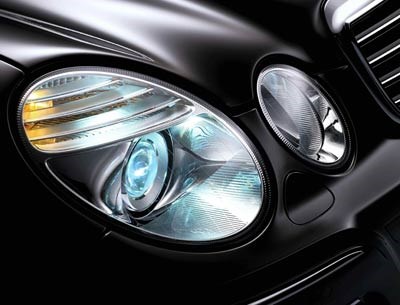Xenon lights look fantastic and offer improved visibility, but they typically involve additional cost. Conversely, Halogen bulbs are cheap and reliable, but they leave room for improvement in lighting quality.
To help shed some light on the real-world benefits of xenon lighting, and what the future of vehicular illumination might have in store, Northern Life’s contributing automotive writer Justin Pritchard had an enlightening conversation with Mercedes-Benz’s David Sherrard about the differences in two types of automotive lighting.
Why do some vehicles have xenon lighting as an option? Is something wrong with regular halogen?
Bi-xenon headlamps, which refer to xenon lamps that function in both the low and high-beam positions, are more costly to produce than halogen headlamps. Regular halogen headlamps work very well, but they don’t provide the same quality of illumination offered by bi-xenon headlamps.
Most test-drives in the shopping process aren’t carried out at night. What are the key differences shoppers can expect if they opt for xenon lighting?
The key benefits to purchasing bi-xenon headlamps versus halogen headlamps include outstanding brightness compared to conventional headlamps, longer service life, significantly improved lighting range in high-beam mode, and clearer and broader illumination of the edges of the road in low-beam mode. Also, the headlight cleaning system provided with bi-xenon lighting on our vehicles ensures that the headlamps remain clean at all times.
Functionally speaking, standard halogen light bulbs are pretty straightforward. How do xenon headlamps work?
The light source in a bi-xenon headlamp is a “gas-discharge” lamp, in which an arc is generated within a quartz cylinder that contains a mixture of gasses. A single gas-discharge lamp is used for both high and low beam settings. In the high-beam setting, the entire beam is used, and when switching to a low-beam setting, a shutter is inserted between the lamp and the lens, blocking out the portion of the beam directed into the distance to prevent dazzling oncoming vehicles.
Who should most strongly consider opting for a xenon lighting system?
Bi-xenon lighting provides benefits to all customers. In the absence of other forms of light, the benefits of bi-xenon technology become abundantly clear, so customers that drive long distances on rural, typically poorly-lit roads will definitely see clear benefits from xenon headlamps.
What’s the difference in maintenance costs? Are those fancy xenon bulbs more expensive to replace?
A typical Halogen bulb is approximately $14 to replace, while a bi-xenon bulb can range from $160 to $213, depending on the vehicle. Remember, the bi-xenon bulbs generally offer a longer service life and deliver a great deal of additional functionality, so they are more costly to produce.
Can’t I just put a set of those fancy halogen bulbs from my local speed shop in my car for the same effect?
No. An authentic, bi-xenon bulb will always deliver superior performance to a halogen unit designed to replicate xenon light.
What other sorts of lighting technologies have your engineers been working on?
Bi-xenon lighting allows for the addition of other lighting technologies. For example, Active Bi-xenon lighting allows the headlamps to follow the driver’s steering movements to swivel around corners — to a maximum angle of 12 degrees. This improves the illumination of bends by approximately 90 per cent when compared with conventional systems, significantly enhancing safety when driving on twisty roads at night.
Our Adaptive Highbeam Assist (AHA) system is now offered on some vehicles, too. It can automatically dim high-beam lights based on the current traffic situation. AHA automatically adjusts the range of the headlamps from high-beam to low-beam in accordance with both the distance to oncoming vehicles and vehicles travelling ahead, always providing the maximum amount of light possible for any situation.
In the future, LED lighting will take on a more prominent role. Lighting in general will become more intelligent, adapting to the road situation to provide the best illumination for the prevailing conditions.
Join Sudbury.com+
- Messages
- Post a Listing
- Your Listings
- Your Profile
- Your Subscriptions
- Your Likes
- Your Business
- Support Local News
- Payment History
Sudbury.com+ members
Already a +member?
Not a +member?
Sign up for a Sudbury.com+ account for instant access to upcoming contests, local offers, auctions and so much more.
